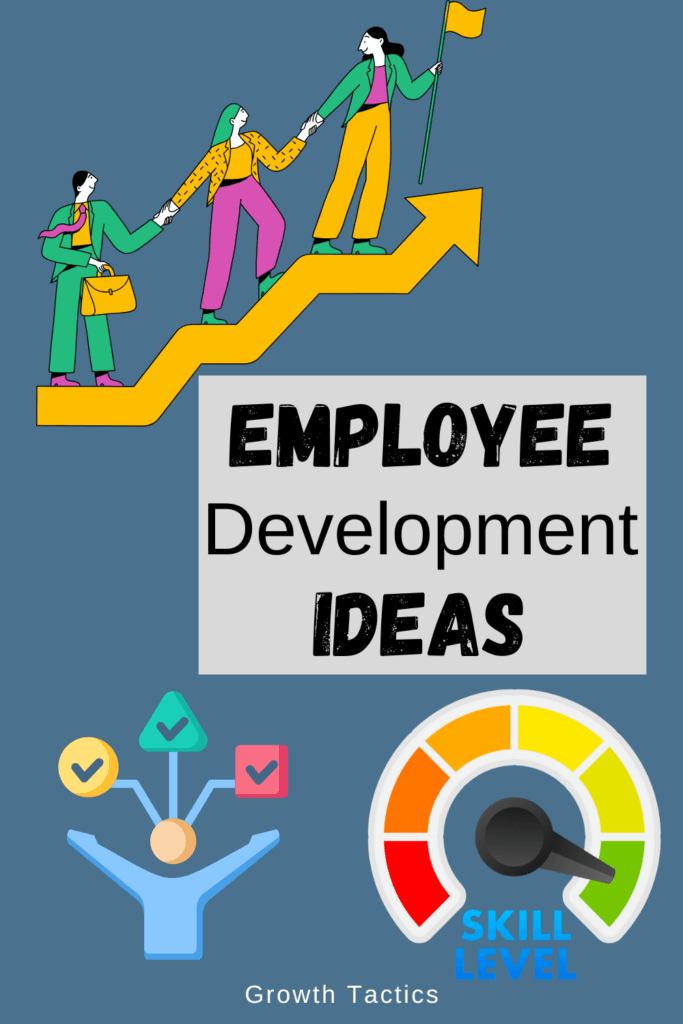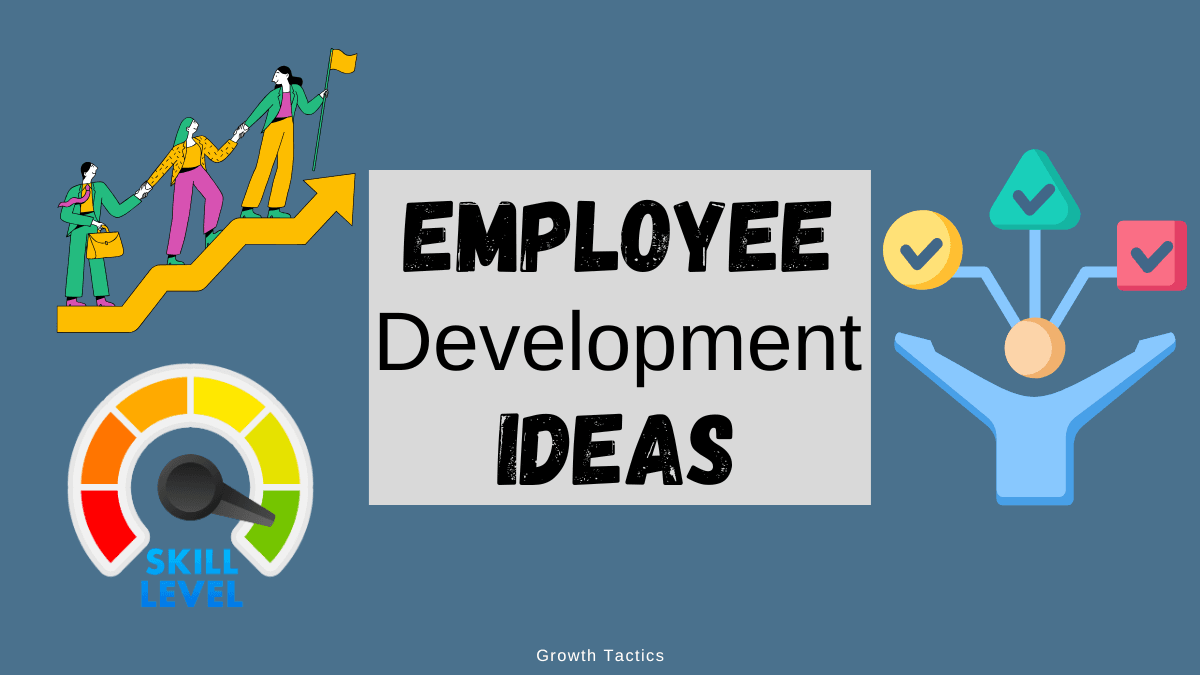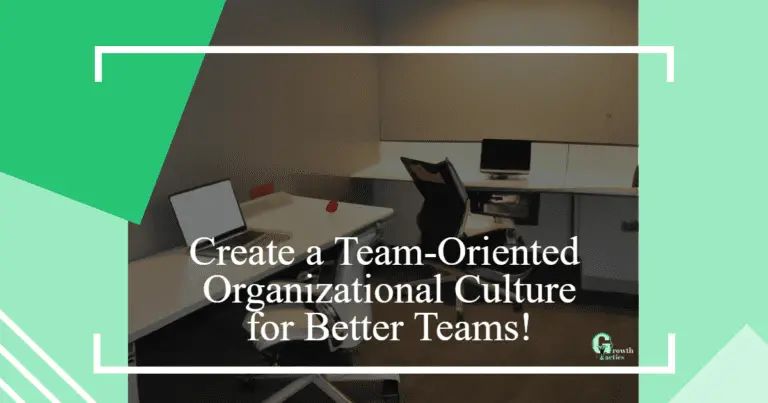The key to a thriving company isn’t just in your products or services. It’s in your people. That’s right, your team members are your most valuable asset. But here’s the catch: they need room to grow.
In this article, we’ll explore some game-changing employee development ideas that’ll light a fire under your team and boost your business.
Jump To Section
Why Is Employee Development So Important?
Employee development isn’t just nice-to-have. It’s a must-have. I’ve seen it transform teams and boost businesses time and time again.
First off, it shows your people you care. When you invest in their growth, you’re saying, “Hey, I believe in you.” That’s powerful stuff. It builds loyalty like nothing else.
But it’s not just about warm fuzzies. It’s about cold, hard results too. Trained employees are more productive. They solve problems faster. They come up with better ideas.
Here’s another thing: it keeps your best people around. Retention is important for growing the best team. Top talent craves growth. If they’re not learning, they’re leaving. I’ve lost great employees because I didn’t give them enough chances to grow. Trust me, you don’t want to make that mistake.
Employee development also future-proofs your business. The world’s changing fast. What works today might not work tomorrow. By constantly developing your team, you’re making sure you’re ready for whatever comes next.
But here’s the real kicker: it creates leaders. Every time you help an employee grow, you’re planting the seeds of future leadership. I’ve watched shy interns blossom into confident managers through consistent development.
So, is employee development important? You bet it is. It’s not just about making better employees. It’s about building a better business, a better team, and a better future. Are you ready to make it a priority?
So let’s get to the employee development ideas that will put you ahead of the competition.
Foster a Culture of Continuous Learning
As a leader, it’s your job to create a company culture where learning isn’t just allowed, it’s celebrated.
Need proof that this works? Look at Google. They came up with something called “20% time.” It’s simple: employees get to spend 20% of their work time on projects they choose. Guess what? This led to some of Google’s biggest innovations, like Gmail and AdSense.
Start by encouraging curiosity. When your team asks questions, don’t brush them off. Dig in. Explore. Maybe you don’t have all the answers, and that’s okay. The goal is to spark new ideas and keep minds active.
Here’s a simple idea: set up a company book club or podcast discussion group. Pick materials that challenge your team to think differently. Then, get together and talk about what you’ve learned. It’s not just about the content, it’s about sharing perspectives and growing together.
Remember, fostering learning isn’t about forcing information down people’s throats. It’s about creating development opportunities and letting your team run with them. Some will dive in headfirst. Others might need a gentle nudge. That’s okay. Everyone learns differently.
Your job? Keep the door to learning wide open. Encourage your team to step through it. Who knows? The next big idea for your company might be just around the corner.
Tailor Development Plans to Individual Needs
Your team members aren’t all the same. Each person has their own dreams, skills, ways of working, and development needs. So why should their development plans be identical?
First things first: get to know your people. Set up regular one-on-ones. These aren’t just about work tasks. Ask about their goals. What gets them excited? Where do they want to be in a year? Five years? Listen closely. You might be surprised by what you hear.
Now, here’s where the magic happens. Take what you’ve learned and create personalized development plans. It’s like making a custom roadmap for each team member. Maybe Sarah wants to improve her public speaking. John might be interested in learning about a new software. Great! Help them find ways to grow in those areas.
Remember, this isn’t about ticking boxes. It’s about helping real people reach their full potential. When you tailor plans to individual needs, you’re saying, “I see you. I hear you. I’m here to help with your employee growth.”
I’ve seen this work wonders. In my early days as a manager, I had a team member who seemed disengaged. During our one-on-one, I discovered he had a passion for data analysis. We adjusted his role to include more of this work. The result? His productivity soared, and he became one of our top performers.
Don’t be afraid to get creative. Maybe someone needs mentoring as part of their career development. Another might benefit from a specific course. The key is to match the plan to the person.
By tailoring development plans, you’re not just helping your team grow. You’re building a culture of trust and respect. And that’s something money can’t buy.
So, are you ready to start creating those personalized plans? Your team is waiting. Let’s make it happen!
Embrace Mentoring Programs
Mentorship is a powerful tool for growth. As a leader, you’ve got the chance to make mentorship a cornerstone of your team’s development.
Start by setting up both formal and informal mentoring opportunities. Formal programs pair mentors and mentees for structured learning. But don’t overlook the power of casual mentoring. Sometimes, the best insights come from a quick chat over coffee.
I remember when I first became a manager. My mentor taught me more in our weekly 30-minute talks than any leadership book ever could. That’s the magic of mentorship; it’s personal, practical, and powerful.
Now, here’s a twist: encourage reverse mentoring. This flips the script. Younger team members mentor older ones, especially on topics like new tech or social media trends. It’s a win-win. The “mentors” feel valued, and the “mentees” gain fresh perspectives.
Remember, mentorship isn’t one-size-fits-all. Some folks thrive with weekly check-ins. Others prefer a more hands-off approach. The key is to match mentors and mentees based on goals, personalities, and learning styles.
So, are you ready to embrace mentorship? It might just be the game-changer your team needs. Give it a shot. You’ve got nothing to lose and everything to gain.
Leverage Online Learning Platforms
In today’s fast-paced world, learning needs to be flexible. That’s where online platforms come in. They’re like a buffet of knowledge, available 24/7. As a leader, it’s your job to set the table.
Start by giving your team access to platforms like LinkedIn Learning. It’s packed with courses on everything from coding to communication skills. But don’t stop there. Udemy, Coursera, and edX are also great options. The key is to find what works for your team.
Here’s a tip: encourage your employees to share their favorite courses. It’s a great way to spread knowledge and build excitement. Maybe Sarah from accounting found an amazing Excel course. Let her tell the team about it. It’s like word-of-mouth marketing but for learning.
Don’t forget to lead by example. Take courses yourself and talk about what you’ve learned. Show your team that learning is a priority, not just a nice-to-have.
Remember, the goal isn’t to overwhelm people with options. It’s to give them the tools they need to grow. Some might dive into long courses, others might prefer quick video tutorials. That’s okay. The beauty of online learning is that it fits everyone’s style.
So, are you ready to unlock the power of online learning opportunities? Your team’s next big breakthrough might be just a click away. Let’s make it happen!
Focus on Soft Skills Development
Soft skills are the secret sauce that turns good employees into great leaders. As someone who’s been in the trenches, I can tell you that technical know-how is important, but it’s soft skills that really make the difference.
Start by offering training programs or workshops on communication, leadership skills, and problem-solving. These aren’t just nice-to-have skills. They’re must-haves in today’s workplace. I’ve seen quiet team members blossom into confident speakers after just a few communication workshops. It’s amazing what a little guidance can do.
But here’s the thing: learning about soft skills isn’t enough. You need to practice them. That’s where role-playing exercises come in. They might feel a bit awkward at first, but trust me, they work.
Don’t forget to tailor these exercises to your team’s needs. Maybe your sales team needs help with active listening. Or perhaps your managers could use practice in giving feedback. The key is to make it relevant and real.
Remember, soft skills aren’t one-size-fits-all. Some people might excel at problem-solving but struggle with public speaking. That’s okay. The goal is progress, not perfection.
So, are you ready to help your employees boost their soft skills? It might just be the edge you need to take your business to the next level. Let’s get started!
Create Cross-Departmental Projects
Let’s shake things up a bit. Cross-departmental projects are like a breath of fresh air of learning and development for your team. They break down silos and spark creativity. As a leader, it’s your job to make these happen.
Start by forming diverse teams for special projects. Mix it up. Put your marketing whiz with your tech guru. Pair your finance expert with your customer service star. It might seem odd at first, but trust me, magic happens when different minds come together.
Now, here’s the real secret: encourage skill-sharing and new perspectives. Let people teach each other. Maybe your IT pro can show the marketing team some coding basics. Or your sales rep can give the tech team tips on customer communication.
Remember, it’s not just about the project outcome. It’s about the learning that happens along the way. People pick up new skills, gain fresh insights, and often discover hidden talents.
Don’t be surprised if these projects lead to some “aha!” moments. I’ve seen people completely change their career paths after working on cross-departmental teams. They discover passions they never knew they had.
So, are you ready to mix things up and boost employee engagement? Cross-departmental projects might just be the key to unlocking your team’s full potential.
Implement a Teach to Learn Employee Development Program
When you teach, you learn twice. It’s a win-win for everyone. That’s why a “Teach to Learn” program can be a game-changer for your team.
Start by encouraging employees to share their skills with others. Everyone’s got something to teach. Maybe Joe in accounting is a whiz with spreadsheets. Or Sarah in marketing has a knack for writing catchy headlines. Let them shine by teaching others.
Host lunch-and-learn sessions led by team members. It’s a great way to make learning fun and casual. Bring in some sandwiches, gather around, and let the knowledge flow. I’ve seen team members come alive during these sessions. They discover a love for teaching they never knew they had.
Here’s a tip: mix it up. Don’t just focus on work skills. Maybe someone’s a great cook or knows how to meditate. These skills can boost well-being and teamwork too. It’s all about learning from each other.
Remember, the goal isn’t to create perfect teachers. It’s to foster a culture of sharing, learning, and professional development. Some sessions might be polished, others a bit rough. That’s okay. The magic is in the effort and the connection.
So, are you ready to turn your team into teachers? A “Teach to Learn” program might just be the boost your company needs.
Conclusion
Remember, great leaders don’t just manage, they inspire growth. These employee development ideas are your toolkit for building a team that’s not just skilled, but passionate and purpose-driven.
Start small, be consistent, and watch your team flourish. The journey of a thousand miles begins with a single step.
So, what’s your first move going to be? Your team is waiting!








